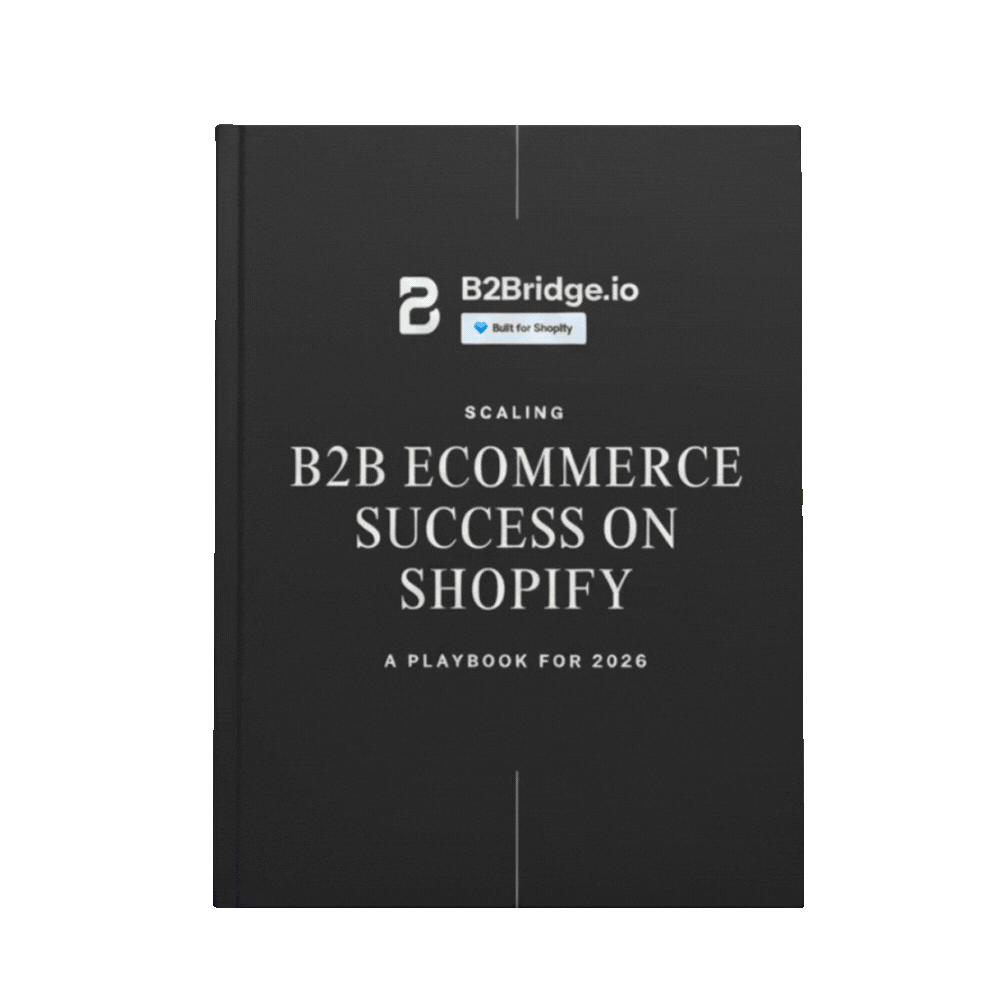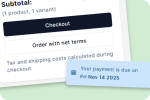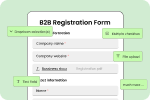B2Bridge has introduced an exciting update to its Public API feature, designed to streamline B2B Ecommerce operations. By providing secure and flexible access to key data like customer groups and price lists, these APIs empower merchants to automate workflows, integrate with existing systems, and deliver personalized pricing experiences. This update marks a significant step forward in enhancing efficiency and scalability for B2B merchants.
What is a Public API?
Public API (Application Programming Interfaces) allows external systems to communicate securely with B2Bridge, enabling you to programmatically manage customer groups, wholesale pricing, storefront locks, and more without manual intervention in your Shopify admin. With API integration, your ERP, CRM, or custom backend can seamlessly integrate with B2Bridge, powering connected, and streamlining B2B operations.
“Please note: Access to the Public API is only available on our Advanced plan.
>> TRY NOW: B2BRIDGE – B2B ALL-IN-ONE

Key Benefits of Public API
Enhanced Automation and Efficiency
Public API enables B2B merchants to automate critical tasks such as updating customer groups and price lists without manual input. This automation reduces administrative overhead, minimizes errors, and accelerates business processes, allowing teams to focus on strategic activities rather than repetitive data management.
ERP/CRM/PIM Integration
The APIs provide a standardized interface to connect B2Bridge with ERP, CRM, PIM, and other backend systems. This integration ensures real-time synchronization of pricing, customer segmentation, and order data across platforms, eliminating data silos and enhancing operational coherence.

Improved Customer Experience
By leveraging Public API, merchants can deliver personalized and accurate pricing and product information to verified B2B customers. This tailored experience increases buyer satisfaction and loyalty by ensuring that customers see prices and terms relevant to their group or contract, which is crucial in B2B commerce where pricing confidentiality and segmentation matter.
Scalability and Flexibility
APIs allow businesses to scale their operations smoothly by supporting growing transaction volumes and complex pricing models without overhauling existing infrastructure. They also offer flexibility to add new features or integrations as business needs evolve, future-proofing the platform against changing market demands.
Security and Data Integrity
Public API uses secure authentication and encryption methods to protect sensitive business data during transmission. This ensures that confidential pricing and customer information remain protected from unauthorized access, which is essential for maintaining trust in B2B relationships.
Faster Development and Innovation
Developers can reuse API endpoints to build new functionalities or customize the platform efficiently, reducing development time and cost. This accelerates innovation, allowing merchants to adapt to unique business requirements or market opportunities quickly.

How It Works
B2Bridge’s Public API focus on two main areas:
- Public API for Customer Groups: Allows management of customer groups, including assigning customers to groups and configuring their payment options and pricing visibility.
- Public API for Price Lists: Enables configuration and updating of price lists, including custom discounts, volume discounts, and purchase limits.
These APIs use RESTful principles, allowing developers to perform create, read, update, and delete (CRUD) operations on these resources. Merchants or developers can authenticate and interact with these APIs to synchronize B2B pricing and customer data with their existing systems, ensuring that customers see accurate B2B prices when logged into the store
Public API for Customer Groups
The Customer Groups API allows B2B merchants to programmatically manage customer segmentation within their store. Through this API, merchants can create, update, and organize customer groups based on various criteria such as location, industry, or account size. This segmentation is crucial for applying differentiated pricing, payment terms, and access permissions tailored to each group.
Key functionalities include:
- Assigning customers to specific groups to control visibility of prices and products.
- Managing group-specific payment options, such as Net 30, Net 60, or Net 90 terms.
- Automating approval workflows for B2B registration and group membership.
- Synchronizing customer group data with external systems like CRM or ERP for consistent segmentation across platforms.
This API enables merchants to maintain precise control over who sees what pricing and terms, ensuring confidentiality and customized experiences for different buyer segments.
Get the access key:
https://b2bridge.gitbook.io/b2bridge/api-integration/public-apis/public-apis-for-customer-groups

Public API for Price Lists
The Price Lists API empowers merchants to define and update pricing structures programmatically. It supports complex B2B pricing models including:
- Custom price lists assigned to specific customer groups.
- Volume discounts based on purchase quantity thresholds.
- Unit pricing adjustments and tiered pricing strategies.
- Price visibility controls to hide or lock prices for non-logged-in or unauthorized users.
With this API, merchants can automate the synchronization of pricing data between B2Bridge and backend systems, ensuring that verified B2B customers always see accurate and up-to-date prices. This reduces manual errors and enables rapid response to market changes or promotional campaigns.
Get the access key:
https://b2bridge.gitbook.io/b2bridge/api-integration/public-apis/public-apis-for-price-lists
Together, these Public APIs provide a robust foundation for automating and customizing B2B commerce workflows, enhancing operational efficiency and delivering personalized buying experiences.
Why This Matters for B2B Merchants
The update to B2Bridge’s Public API is especially significant for B2B merchants because it addresses key challenges in modern B2B commerce by enabling seamless integration, automation, and real-time data exchange.
In today’s fast-paced business environment, APIs serve as bridges that connect legacy systems like ERP with modern platforms, allowing merchants to leverage advanced features such as real-time pricing updates, customer segmentation, and automated order processing without costly infrastructure overhauls.

For B2B merchants, this means they can customize and streamline their commerce workflows to better meet complex buyer requirements. The APIs facilitate synchronization between B2Bridge and other critical business systems, reducing manual data entry, minimizing errors, and ensuring consistent, up-to-date information across channels. This improves operational efficiency and enhances the customer experience by delivering accurate, personalized pricing and product information to verified buyers.
Moreover, the scalability and flexibility of API-driven integrations allow merchants to quickly adapt to changing market demands and expand their business reach globally. Secure data exchange and encryption built into these APIs also protect sensitive pricing and customer data, which is vital for maintaining trust in B2B relationships.
Ultimately, B2Bridge’s Public API empowers B2B merchants to innovate, automate, and scale their operations efficiently, giving them a competitive edge in a complex and evolving marketplace.
Whether you’re managing hundreds of wholesale clients or complex pricing structures, APIs give you the flexibility and control your B2B business needs to scale efficiently.
Case Study 1: How Brooklyn Bicycle Co. Connects NetSuite and Shopify with B2Bridge
Brooklyn Bicycle Co. struggled to scale their Ecommerce business while keeping inventory and orders accurate across NetSuite and Shopify. Manual data entry caused processing bottlenecks, fulfillment delays, and frequent stock mismatches that affected customer satisfaction.

After adopting B2Bridge, Brooklyn Bicycle achieved a real-time, automated sync between Shopify and their NetSuite ERP. The integration streamlined inventory updates, order flow, and customer data, while preserving operational clarity between wholesale and retail channels.
Key Results:
Manual order entry was eliminated, order processing became significantly faster, and inventory discrepancies were nearly zero. The team gained real-time visibility into stock across all sales channels. Orders now flow automatically from Shopify into NetSuite for fulfillment, while status updates sync back to Shopify to keep customers informed. With B2Bridge managing the complexity, Brooklyn Bicycle can scale confidently without sacrificing data accuracy.
Read more: Inventory Management: Definition, Benefits, Formula, Techniques & Examples
Case Study 2: How Trailer Valet Automates ERP Integration on Shopify with B2Bridge
As Trailer Valet expanded their Shopify store, managing a highly configurable product catalog with strict inventory accuracy became increasingly complex. They needed a reliable ERP connection that could support custom pricing, product configurations, and fast fulfillment – without manual intervention or sync errors.

B2Bridge delivered a tailored integration layer that seamlessly connects their ERP system with Shopify. The solution handles catalog nuances, pricing rules, inventory, orders, and customer data, ensuring consistent and accurate information across both platforms.
Key Results:
Trailer Valet now operates with real-time inventory confidence, faster order-to-shipment cycles, and improved customer service. Their team can access full order histories and live stock availability instantly, enabling quicker support and better commitments to buyers. By removing integration friction and manual work, B2Bridge allows Trailer Valet to focus on growth and customer experience, strengthening their position in the competitive trailer equipment market.
Conclusion
B2Bridge.io plans to continue evolving its Public API by adding more endpoints, improving security, and increasing performance. The roadmap includes enhanced error handling, versioning to support backward compatibility, and higher rate limits to support growing API usage. These improvements will further empower merchants to build sophisticated B2B experiences and integrations, fostering innovation and growth in the B2B Ecommerce space
>> See more of our new feature updates:
Unit Price Feature: Advanced Quantity-Based Pricing for B2B Merchants
B2Bridge Manual Orders To Simplify B2B Orders
Lock/Hide Feature: A Powerful Update for B2B Ecommerce
Import & Export Price List Feature – Simplify Your B2B Pricing Management

Hi, I’m Tri, a tech enthusiast. With over 4 years of hands-on experience with Shopify and a total of eight years in technology and ecommerce, I currently serve as a Technical Leader on Shopify app development projects. My goal is to contribute solutions that are user-friendly, stable, and scalable within the Shopify App ecosystem.







